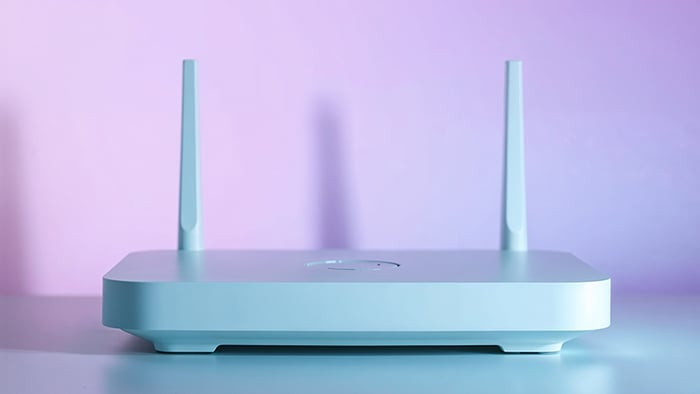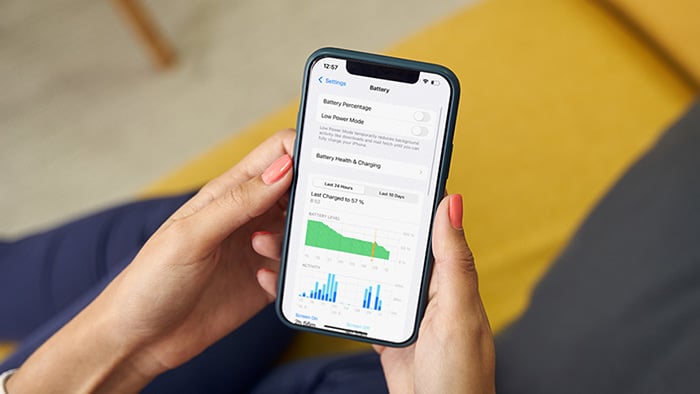What is a computer network?
A computer network is any system that connects two or more computers or devices to share data, resources, and services. These connections can be established through physical cables, like fiber optics, or wirelessly via radio signals. Networks vary in type and scale, from small local area networks (LANs) to expansive wide area networks (WANs).
At the heart of any network is its ability to enable resource sharing and support communication and collaboration across devices. By connecting multiple endpoints, a network allows users to send and receive information quickly and efficiently. Whether you're accessing a file on a remote server, sending an email, or streaming a video, networks underpin the seamless flow of data.
The concept of computer networking dates back to the late 1960s with the development of ARPANET, the first operational computer network. Funded by the U.S. Department of Defense, ARPANET was designed to let research institutions exchange information quickly and reliably. It laid the foundation for today’s internet — the largest and most complex computer network in existence.
What are the components of a networking system?
A computer network relies on several key components to function smoothly. From the routers, switches, and servers that direct traffic, to the protocols such as TCP/IP, HTTPS, and WEP or WPA that help data move securely and efficiently, each part plays its role in allowing data to move between connected devices.
Network devices
Network devices form the backbone of any computer network: the hardware that connects, directs, and manages the flow of data. Known collectively as “nodes,” they form the infrastructure that keeps digital communication running smoothly.
-
Routers direct data between networks. Often confused with modems, which connect local networks to the internet, routers manage traffic within your local network and distribute internet access to multiple devices.
-
Servers store, manage, and distribute data or services across a network. They respond to requests from client devices, delivering web pages, email, applications, and more.
-
Switches link local devices, like computers and printers, and ensure that data is sent only to the intended recipient. Unlike basic hubs, which broadcast data to all connected devices, switches intelligently manage traffic, improving speed and efficiency.
-
Gateways act as bridges between different networks or protocols. When systems using different formats need to communicate, gateways "translate" the data so everything works together seamlessly.
Wired and wireless links
Links are the connections that enable devices in a network to communicate and exchange data. Whereas logical links represent the path that data takes across the network, and are managed by software and protocols, physical links refer to the actual wired and wireless pathways that connect devices.
The three most common types of physical links are:
-
Wired links, such as Ethernet cables, use physical connections to transfer data between devices. They’re often favored for their stability, lower latency, and consistent speed — ideal for high-demand environments like offices or gaming setups.
-
Wireless links rely on radio waves, like those used in Wi-Fi networks. They allow devices to connect without the constraints of physical cabling, offering greater flexibility and mobility, which is useful in homes, workplaces, and public spaces.
-
Optical links use fiber-optic cables to transmit data as pulses of light. These are the fastest and most bandwidth-rich connections available, capable of handling massive amounts of data over long distances with minimal loss.
Understanding the type of link your device uses — and how it's configured — can make a big difference in performance. If your network feels sluggish, explore practical tips on how to speed up your internet connection or dig into the reasons why your phone’s internet is so slow.
Network protocols
Just as people rely on shared languages to communicate, devices in a network depend on protocols — established rules that govern how data is formatted, transmitted, and received. These protocols ensure that communication between devices is consistent, accurate, and secure, regardless of the underlying hardware or software.
At the heart of most networking systems is the TCP/IP model, which organizes communication into four conceptual layers:
-
Network access layer: Handles the physical transmission of data over media such as cables, fiber optics, or wireless signals.
-
Internet layer: Breaks data into packets and ensures it reaches the correct destination, even across multiple networks.
-
Transport layer: Establishes a reliable connection between devices and ensures that data arrives intact and in order.
-
Application layer: Interfaces with software applications (e.g., web browsers, email clients) that generate and consume network data.
The TCP/IP model is a streamlined, practical counterpart to the more detailed Open Systems Interconnection model (OSI), which divides networking into seven layers. While OSI is often used for teaching and conceptual clarity, TCP/IP is what powers most real-world communications today.
Other common protocols include User Datagram Protocol (UDP), which supports fast, connectionless data transfers; IEEE 802, a family of standards for local (LAN) and metropolitan (MAN) networks; Ethernet, which governs wired network connections; Wi-Fi (wireless LAN) the protocol for wireless local area networking; and cellular standards, which define how mobile networks operate and communicate across devices.
What are the different network topologies?
Computer networking topology refers to the physical or logical layout of devices and connections in a computer network. It defines how nodes are interconnected and how data flows between them. Each topology has strengths and trade-offs, and the right choice depends on factors like performance needs, budget, reliability, and ease of maintenance.
 Network topology defines how data flows through connections between devices.
Network topology defines how data flows through connections between devices.
Here’s a closer look at the most common network topologies:
Star network
In a star network, all devices connect to a central hub (typically a router) via dedicated links. These connections radiate outward from the hub, forming a star-like pattern. The hub manages data transmission between devices and acts as the network’s central point of control.
Typical use cases: Home and office Wi-Fi networks.
Pros

Simple to set up, manage, and scale.

A single device failure doesn’t affect the rest of the network.
Cons

If the central hub fails, the entire network is disrupted.

Performance may degrade as more devices compete for the hub’s bandwidth.
Ring network
In a ring topology, each device connects to exactly two others, forming a closed loop. Data travels around the ring, passing through each device until it reaches its destination.
Typical use cases: Legacy telephone infrastructure, Metropolitan Area Networks (MANs), industrial control systems.
Pros
Cons
Full or partial mesh network
A mesh network features multiple paths between devices, forming a web of connections. In a full mesh, every device is directly connected to every other device, offering maximum redundancy. In a partial mesh, only some devices are directly linked, balancing reliability with cost.
Typical use cases: Satellite constellations, military radio networks, the internet.
Pros
Cons
Bus network
A bus topology connects all devices to a single central cable, called the backbone. Data travels along this backbone, and each device monitors the traffic to identify messages intended for it.
Typical use cases: Early Ethernet networks in schools; small local networks, such as cash register systems.
Pros
Cons
Tree network
A tree topology blends features of bus and star networks. It uses a central backbone cable that branches out into multiple star-configured segments, making it ideal for organizing large, segmented environments.
Typical use cases: University campuses or corporate office buildings.
Pros
Cons
Client servers or peer-to-peer networks?
Computer networks typically follow one of two main architectures: client-server or peer-to-peer (P2P). Both rely on effective communication between connected devices, but they differ significantly in structure, scalability, and control.
The client-server model connects multiple client devices to a central server that manages data, applications, and access control. Clients don’t share resources directly; instead, they request them from the server, which then routes data back to the originating IP address. This model suits businesses needing centralized access, security, and management, though it requires dedicated hardware and maintenance.
In a P2P network, each device functions as both a client and a server, sharing files and resources directly. It’s commonly used for file sharing or resource-intensive applications. P2P networks are easy to set up and cost-effective, but harder to secure and scale. Using a P2P VPN can enhance privacy and protection when on a P2P network.
 Peer-to-peer networks are more flexible and distributed than centralized client-server setups.
Peer-to-peer networks are more flexible and distributed than centralized client-server setups.
What types of computer networks are there?
There’s no one-size-fits-all network. The best choice depends on factors like the number of connected devices, operating systems, chosen topology, geographic scale, and physical distance between nodes.
Here are the most common network types:
-
Local Area Networks (LANs) connect devices within a small, localized area, such as a home, office, or classroom. LANs enable fast communication and easy sharing of printers, files, and applications.
-
Wide Area Networks (WANs) span large geographic areas by linking multiple LANs through public or private infrastructure like fiber-optic cables or satellites. A multinational bank connecting its global branches is a typical example.
-
Wireless Local Area Networks (WLANs) function like a LAN but wirelessly, offering flexibility and mobility. If you’ve ever used free public Wi-Fi in a coffee shop, that’s a WLAN in action.
-
Metropolitan Area Networks (MANs) connect a city or campus by linking several LANs, usually via high-speed fiber-optic connections. MANs are commonly used by universities, government agencies, or large businesses across urban areas.
-
Virtual Private Networks (VPNs) create secure, encrypted tunnels over public or private networks, allowing remote users to access a LAN or the internet safely. VPNs are widely used for secure remote work and protecting data privacy.
-
Service Provider Networks (SPNs) are large-scale networks operated by ISPs like Verizon or BT to deliver internet, phone, and television services to homes and businesses across regions or entire countries.
The benefits and risks of computer networks
The good, the bad, and the hackable? Computer networks have transformed nearly every aspect of modern life — from how we work and learn to how we shop, socialize, and receive healthcare. Virtually every industry now relies on seamless digital connectivity. But with greater convenience comes greater exposure to risks that can impact our privacy and security.
The pros: Why we love computer networks
Just by reading this article, you’re already enjoying the power of computer networks. Here’s why they’ve become essential to modern life:

Information sharing: Whether it's a work document, a funny GIF, or a 4K movie, we can share information at lightning speed without a cable or USB stick in sight.

Seamless, instant connectivity: Thanks to networks, it’s easier than ever to keep in touch with friends, family, and co-workers — whether through emails, instant messaging, video calls, or social media updates.

Centralized resources: Whether you need to print something from another room or want to access files from another device, networks put capabilities and files at your fingertips. Multiple users can share hardware, software, and data.

Entertainment on demand: We have the freedom to game with friends across the globe and stream the latest series. Computer networks have banished boredom and redefined downtime.
The cons: Why security experts love to hate them
It’s not all good news. Networks make our digital lives possible — but they also open the door to a range of cybersecurity threats that can compromise privacy, disrupt services, and expose sensitive data.

Malware infections: Malicious software, such as viruses, ransomware, and spyware can spread rapidly across a network — stealing information, encrypting files, or crippling systems.

DDoS Attacks (Distributed Denial-of-Service): Cybercriminals launch DDoS attacks by flooding a network with traffic to overwhelm servers and shut down online services.

Hacking and unauthorized access: Hackers love network vulnerabilities they can slip through to gain unauthorized access to systems and data. The result? Data breaches, financial theft, or manipulation of sensitive information.

Social engineering attacks: Attackers can also target people, using social engineering tactics such as phishing emails to trick users into giving up passwords or sensitive information.

Router hacking and network exploits: A hacked router can give attackers control over the entire network. They may intercept traffic, redirect users to malicious websites, or install backdoors that allow malware and other threats to enter undetected.
Network security — protecting your computer network
Without strong defenses, computer networks are more vulnerable to cyberattacks, unauthorized access, and data leaks. Fortunately, a range of tools and techniques can help secure networks and protect sensitive information.
-
Firewalls: Acting as a digital gatekeeper, a firewall monitors network traffic and blocks unauthorized access. It creates a barrier between your trusted network (like a home or office) and the open internet.
-
Proxy servers: By acting as intermediaries between a user’s device and the internet, proxy servers mask your IP address, filter web traffic, and add a layer of privacy and control.
-
Single sign-on (SSO): Allowing users to log in to multiple apps or services with one secure set of credentials, SSO reduces password fatigue and lowers the chance of weak or reused passwords.
-
2FA or MFA: Using two-factor authentication or multifactor authentication adds extra login verification steps such as a one-time code or biometric check, making it much harder for attackers to gain unauthorized access to accounts or systems.
-
Intrusion Detection Systems (IDS): Like a network watchdog, an IDS monitors traffic for suspicious behavior and alerts administrators to potential breaches or threats in real time.
No computer network is a completely impenetrable fortress, but multiple layers of protection are safer. (Imagine thick walls. Now add archers, a moat, and crocodiles).
Help secure your computer network with Avast
Understanding the risks is only the beginning — real network protection means staying one step ahead. That means strong passwords, up-to-date software, and smart, reliable security tools. Avast Free Antivirus offers powerful, multi-layered protection, including advanced anti-malware detection and removal, a smart firewall, and home Wi-Fi security — all completely free and easy to use on all your devices.
















